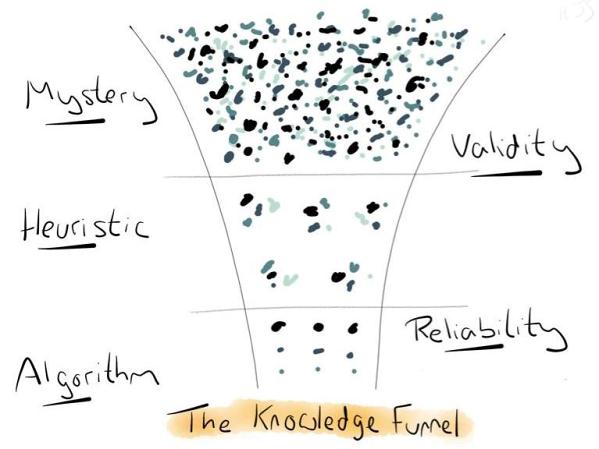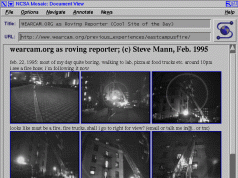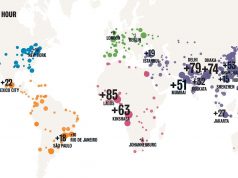Roger Martin’s explanation on heuristic thinking’s place in the knowledge funnel. In a commercial world where efficient production is now a well distributed commodity, the market has to create new, value-added products and services to promote economic growth. Heuristic thinking offers a solution.
The founder of MESH Cities is often asked, “What does MESH stand for?” We’ve explained the acronym in previous posts, as well as in a variety of interviews; none-the-less, the functional parts of a truly MESHed city are complex—really complex. For practitioners of modern city building, having access to the strategic tools offered by this smart city evolution are essential to getting modern city design right. That’s the reason we will deep dive into one facet of MESH: Heuristics.
To begin with, let’s agree that cities are messy. Eclipsed only by incomprehensible geopolitics, they also offer the ideal breeding ground for wicked problems—societal riddles so tangled that sensible people avoid them. The school of hard knocks tests designers whenever they take on the Sisyphean task of changing familiar city patterns. Rarely does the result get a passing grade. What can MESH Cities thinking do to up the pass/fail rate?
In the MESH City schema city designers, builders, and managers enter into a continuous improvement cycle where data are always collected and used to learn what solutions work. All that information, however, opens up new opportunities–not to mention challenges. Often data takes us places we don’t understand. Enter Human (or, for the sake of theorists, Heuristics).
H for Human or Heuristics, for those readers unfamiliar with the term, is a process people can adopt to tackle problems without obvious solutions. It is a conceptual framework referred to in math and computer science circles for good reason. Practitioners in those fields are often given the task of getting from point A to point B without an existing map–an all too human condition. We too can adopt the idea because MESH Cities succeed not only due to stellar design, they rely on some big, science-driven technologies too. And the design teams essential to getting the job done need a common approach to problem solving.
Not surprisingly then, one of the most recognized texts on the art of heuristics comes from 20th century mathematician George Pólya. Borrowing from Wikipedia, we offer this five step guide to heuristic approaches embelleshing ideas from Pólya’s book, “How to Solve It.”
First principle: Understand the problem
This may sound obvious to design and planning professionals, but more lost problem-solving time can be attributed to not understanding the problem in the first place. We’ve all done it. We think we know the answer right away then go about rationalizing our great insight. Hours, even days later something or someone helps us focus on the real issue we completely missed. These kinds of knee-jerk misfires are even more disastrous when designing for intelligent cities–infrastructure is expensive, bad infrastructure even more so.
Here, then, is how design teams can go about understanding those wicked, smart city design problems in a systematic way:
- What are they asked to discover or improve?
- Can the problem be restated in simple words rather than in jargon?
- Is there a picture or a diagram that will help your colleagues better understand the problem?
- Is there even enough information available to find a solution?
- Does your team understand all the words and concepts used in stating the problem?
- Do you need to ask a question (of someone) to get the answer?
Second principle: Devise a plan
Professional designers have seen it all. Many default to their standard Operating Procedures. That could be a mistake. Having an agreed to plan on how to tackle problems increases the likelyhood of solving them especially across large, diverse design teams.
So here is how a MESHed design plan might be structured:
- Make an orderly list, or even a matrix of the problem environment
- Eliminate possibilities–get rid of items that don’t fit
- Use symmetry (or what we’d call a preponderance of small, correct types to push the needle forward)
- Consider special cases–is there a solution that worked somewhere else in a different situation?
- Look for a pattern your team is familiar with (patterns can lead to analogs, analogs to solutions)
- Draw a picture–really . . . draw one, or ten
- Solve a simpler problem that is similar and look for connections
- Use a model (and by this we mean a conceptual model, but use simulations too)
- Work backward (what does the ideal solution contribute to its own development?)
- etc. (there are numerous problem-solving approaches out there . . . use some of them
Third principle: Carry out the plan
This step is usually easier than devising the plan. In general, all your team needs is care and patience, given that they have the necessary skills. Persist with the plan chosen. If it continues not to work discard it and choose another. Don’t be misled; this is how, for example, mathematics is done, even by professionals.
Fourth principle: Review/extend
Pólya mentions that much can be gained by taking the time to reflect and look back at what you have done, what worked and what didn’t. That’s the whole point of including “H” in the MESH Cities method. Doing this will enable you to predict what strategy to use to solve future problems.
Fifth principle: Document where you’ve been
The whole point of this structured approach is to bring new products and processes to the canon of city building solutions. That means your work must be documented in a way that is accessible to others. Build a wiki, website, mobile App, database, document managing system, and/or whatever else allows team members and citizens to access your work. After all, the point of all this work is to improve the public realm.
Conclusion
We offer readers this far from comprehensive guide to MES(H) in the hope that these tools will help build the intelligent cities of tomorrow. Skilled designer teams already have structured systems, but it is good practice to follow a checklist when dealing with mission-critical procedures. Ask any airline pilot.
In a more abstract sense, thinking heuristically when building responsive, intelligent cities allows for improved efficiency to be sure, but it also allows new solutions to old problems. Those new solutions not only help build smart cities, they build smart economies too.
(PS: If you have some great ideas on how to tackle wicked problems like cities you’d like to share, let us know.)







